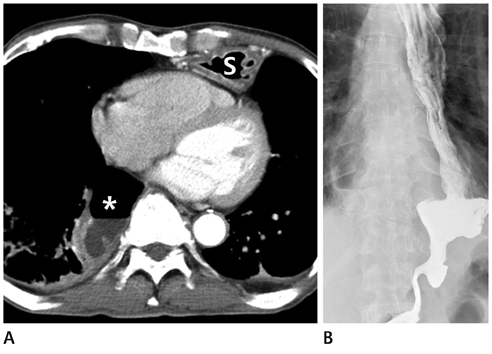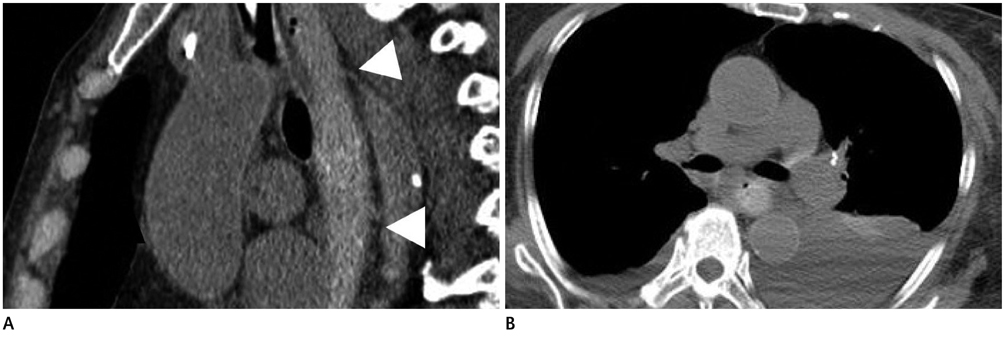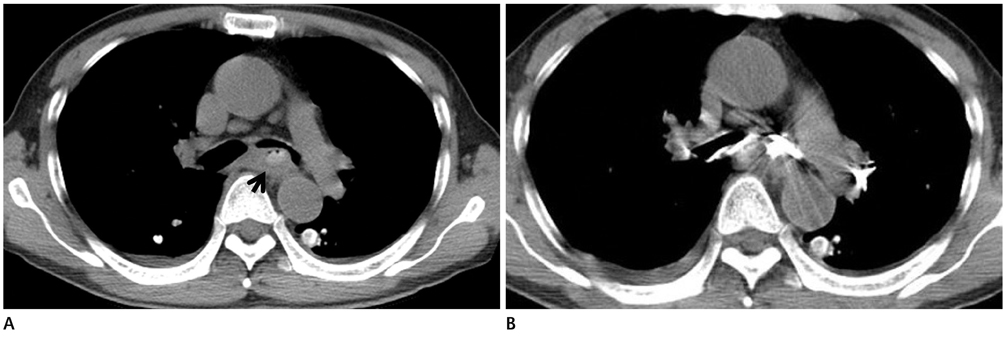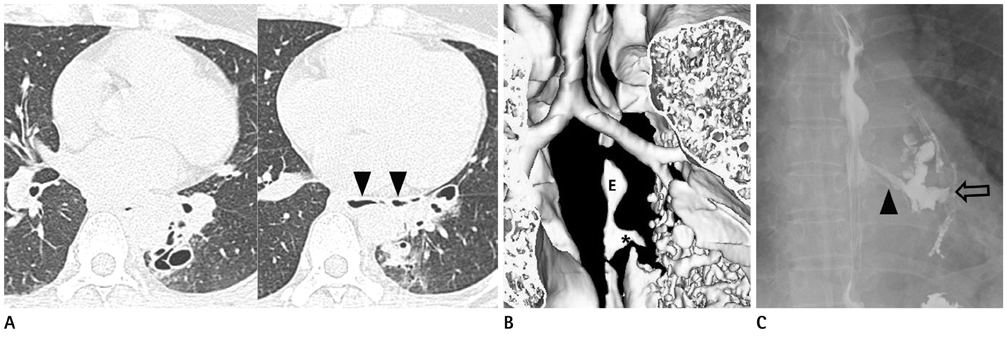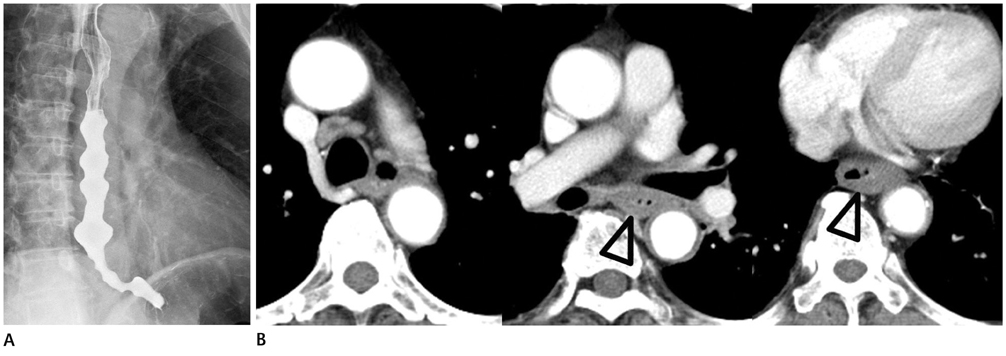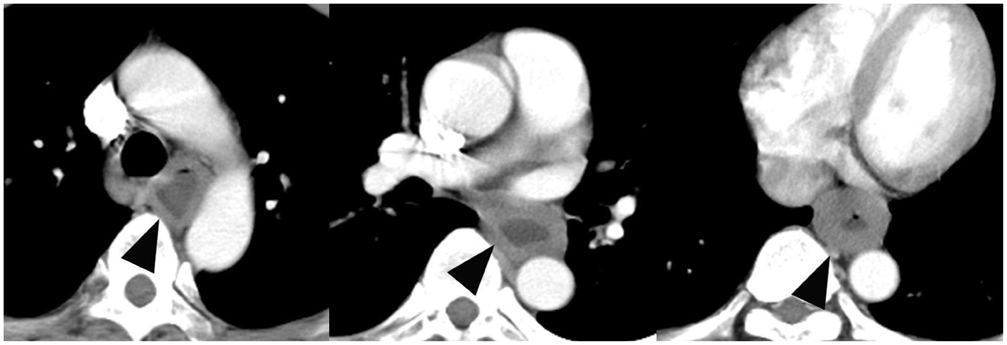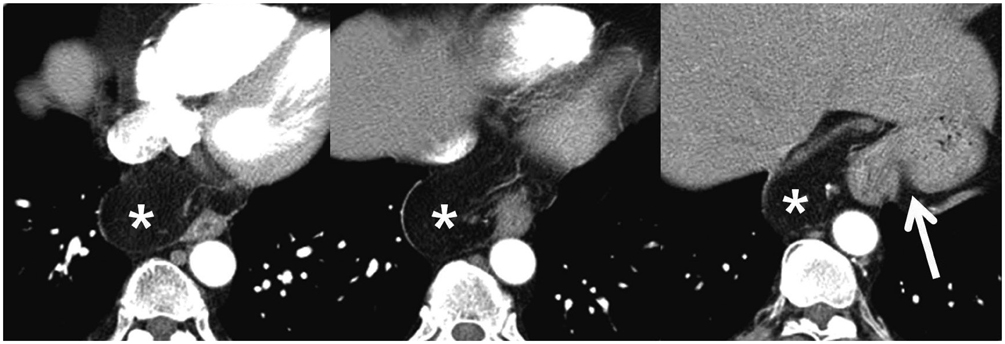J Korean Soc Radiol.
2013 Jul;69(1):43-51. 10.3348/jksr.2013.69.1.43.
Non-Neoplastic Disorders of the Esophagus
- Affiliations
-
- 1Department of Radiology, Soonchunhyang University College of Medicine, Cheonan Hospital, Cheonan, Korea. ytokim@schmc.ac.kr
- KMID: 2002889
- DOI: http://doi.org/10.3348/jksr.2013.69.1.43
Abstract
- Non-neoplastic disorders of the esophagus include esophagitis, esophageal diverticulum, esophageal injury, foreign body, fistulous formation between the esophagus and the surrounding structures and mucocele. Since these disorders have variable symptoms and radiologic findings, it needs to differentiated from other disorders other than esophageal diseases. Being knowledgeable of CT findings suggest that these disorders can help diagnose non-neoplastic disorders of the esophagus. The purpose of this pictorial essay is to review the CT appearance of non-neoplastic disorders of the esophagus.
Figure
Reference
-
1. Lee KH, Cho SG, Jeon YS, Jeong S, Kim HJ. Spectrum of esophageal abnormality seen on thoracic CT. J Korean Radiol Soc. 2006; 54:273–282.2. Reinig JW, Stanley JH, Schabel SI. CT evaluation of thickened esophageal walls. AJR Am J Roentgenol. 1983; 140:931–934.3. Berkovich GY, Levine MS, Miller WT Jr. CT findings in patients with esophagitis. AJR Am J Roentgenol. 2000; 175:1431–1434.4. Young CA, Menias CO, Bhalla S, Prasad SR. CT features of esophageal emergencies. Radiographics. 2008; 28:1541–1553.5. Giménez A, Franquet T, Erasmus JJ, Martínez S, Estrada P. Thoracic complications of esophageal disorders. Radiographics. 2002; 22(Spec No):S247–S258.6. Katabathina VS, Restrepo CS, Martinez-Jimenez S, Riascos RF. Nonvascular, nontraumatic mediastinal emergencies in adults: a comprehensive review of imaging findings. Radiographics. 2011; 31:1141–1160.7. Mangi AA, Gaissert HA, Wright CD, Allan JS, Wain JC, Grillo HC, et al. Benign broncho-esophageal fistula in the adult. Ann Thorac Surg. 2002; 73:911–915.8. Braimbridge MV, Keith HI. Oesophago-Bronchial fistula in the adult. Thorax. 1965; 20:226–233.9. Lazopoulos G, Kotoulas C, Lioulias A. Congenital bronchoesophageal fistula in the adult. Eur J Cardiothorac Surg. 1999; 16:667–669.10. Erasmus JJ, McAdams HP, Goodman PC. Diagnosis please. Case 5: esophageal mucocele after surgical bypass of the esophagus. Radiology. 1998; 209:757–776.11. Haddad R, Teixeira Lima R, Henrique Boasquevisque C, Antonio Marsico G. Symptomatic mucocele after esophageal exclusion. Interact Cardiovasc Thorac Surg. 2008; 7:742–744.12. Dogan I, Puckett JL, Padda BS, Mittal RK. Prevalence of increased esophageal muscle thickness in patients with esophageal symptoms. Am J Gastroenterol. 2007; 102:137–145.13. Goldberg MF, Levine MS, Torigian DA. Diffuse esophageal spasm: CT findings in seven patients. AJR Am J Roentgenol. 2008; 191:758–763.14. Kato N, Iwasaki H, Rino Y, Imada T, Amano T, Kondo J. Intrathoracic omental herniation through the esophageal hiatus: report of a case. Surg Today. 1999; 29:347–350.15. Ko SF, Hsieh MJ, Lin JW, Huang CC, Li CC, Cheung YC, et al. Bronchogenic cyst of the esophagus: clinical and imaging features of seven cases. Clin Imaging. 2006; 30:309–314.
- Full Text Links
- Actions
-
Cited
- CITED
-
- Close
- Share
- Similar articles
-
- The Nutcracker Esophagus in a Patient with Dermatomyositis
- Role of artificial intelligence in diagnosing Barrett’s esophagus-related neoplasia
- Two Distinct Types of Hypercontractile Esophagus: Classic and Spastic Jackhammer
- Longitudinal Muscle Dysfunction in Achalasia Esophagus and Its Relevance
- Sex/Gender Differences in Esophageal Motility Disorders





